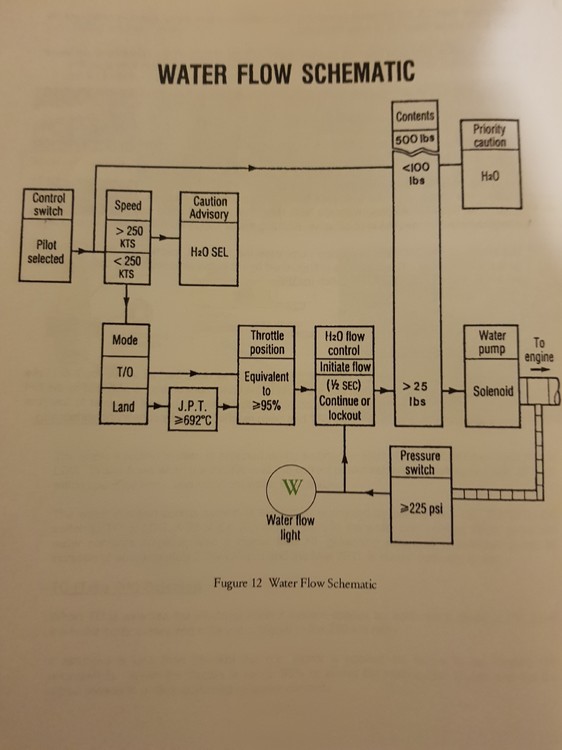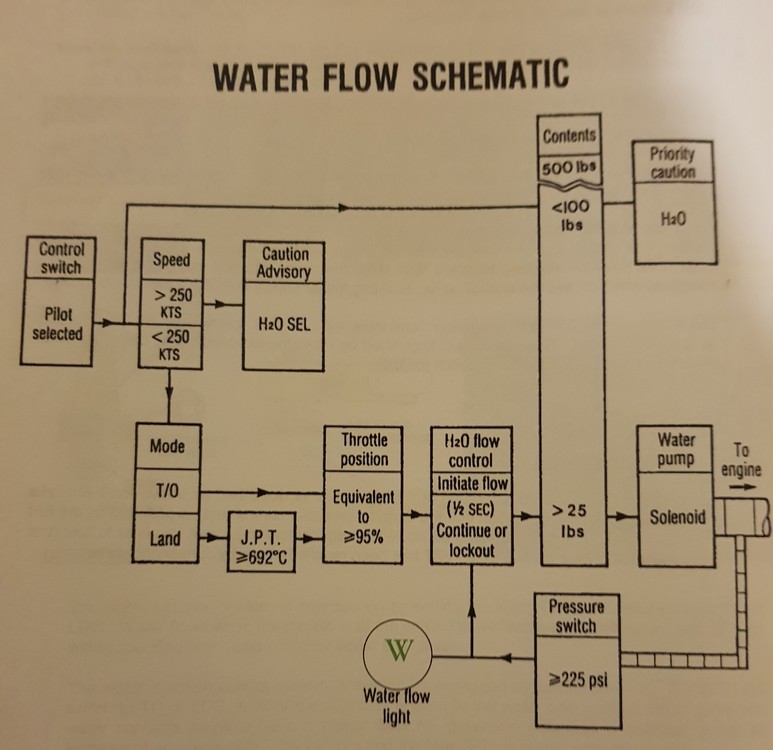-
Posts
230 -
Joined
-
Last visited
Content Type
Profiles
Forums
Events
Everything posted by robmlufc
-
Correct
-
You can drop the undercarriage (Helium filled blow down bottle) and flap the rudder (manual reversion) around a bit when you run out of engine. The other flying controls are all powered purely from the hydraulic pumps connected to the engine.
-
-
Mvsgas scan says exactly that water flows until airspeed exceeds 250kts.
-
No, water should always stop flowing above 250kts. You should get a H20 Sel caption above 250kts. The only difference between the two modes is the JPT requirement in Land mode. I've attached the water flow logic.
-
The only difference is that in LDG the water does not start flowing until JPT is above 692Deg C (Max normal lift dry JPT), to conserve water.
-
Haha, I know the feeling!
-
Yeah water flow is constant at about 225psi pressure. WAR, are you ex JFH?
-
Certainly with the older less powerful engines, water was always required for hovering, even with pylons removed. I can't speak so much for the AV8B but on the Gr7/9 with the latest mk107 engine, the water was only really there as ballast and for use in hot high altitude conditions.
-

What fighters were the Argentinians using in the Falklands?
robmlufc replied to Neil Gardner's topic in AV-8B N/A
Worth remembering that the carrier Veinticinco de Mayo spent most of the conflict hiding in port, after the General Belgrano was sunk. The conflict may well have been fought differently if that was not the case. -
On the real aircraft you just lift the switch up and it springs back down once you're passed idle. Much like the warthog shut off. The nozzles move even when the engine isn't running, not sure if that has been mentioned. Loving it so far though, brings back memories!
-
Cott mostly for me! Started with the GR9 JUMP program and was there till the end. I miss the Harrier Force days.
-
I guess you were at Cottemore or Wittering Harry?
-
That's the GR9 development airframe, which is why it's loaded with Brimstones. I think only 2 airframes had that capability before the Harrier was binned.
-
RPS is Rudder Pedal Shaker Q Feel is the artificial feedback for the flight controls, it provides the pilot with resistance on the stick and rudder pedals depending on airspeed and altitude. It's a hydraulic system.
-
We used to remove the pylons (wet and dry) when the aircraft was doing a display, it would buy them a few extra seconds of hover time.
-
True that. I tried to find a photo on them of open in flight but I guess it's a tricky shot to take!
-
Maybe so! It's definitely a LIDS fence though, the engineers said so ;)
-
I've never heard or seen it called that! I can guess you can call it whatever though. The LIDS switch in the cockpit retracts the LIDS fence.
-
As mentioned, the auxiliary air doors on the outside of the intake are just hinged to open and closed under their own weight or pressure/vacuum in the intake. They are a bugger to fit. There is a second set of doors called the boundary layer doors, which sit on the inboard section of the intake, 2 each side. These are sprung loaded closed and open to vent off excess pressure in the intake. You can see them here, vertical just behind the intake leading edge.
-
On the Harrier, the LIDS fence and strakes are different components. The strakes are interchangeable with the gun pods. We used to sometimes fit gunpods because there wasn't enough strakes for the entire fleet. The LIDS fence sits just behind the nose leg and opens in certain configurations. U/C down and nozzles and/or flaps in a certain position. I'll have to check. Tusks were great for hanging your hivis/coat/bump cap/ear defenders on! The AV8B also flare launchers on the top of the rear fuselage, between the wing and the fin. As opposed to the GR7/9 which has a flare launcher underneath, just next to the airbrake.
-
The engine modes 'wet' and 'dry' were governed but the water switch position, gear selector and possibly nozzle position, my memory fades a little there. It's perfectly possible to demand water flow from an empty tank, which is never good. Zeus, I seem to remember the limit of short lift wet being 107%? I'll have a dig around in my old notes later.
-
Looks great! It was always fun doing a BIT test on the flap system, they would nearly bounce the aircraft off jacks.
-
I'm pretty sure the nozzles will be mappable to an axis, I'm sure that's how they are on the FSX version? The nozzle position is displayed on the EPI (Engine Performance Indicator), top right of the cockpit. Along with JPT, water flow, stab position, duct pressure, engine rpm and fuel flow.
-
Spot on! The Harrier system is called SAAHS (Stability Augmentation and Attitude Hold System). It also assists the pilot in a hover, with the RCS valves being mechanically linked to the control surfaces with rods.



